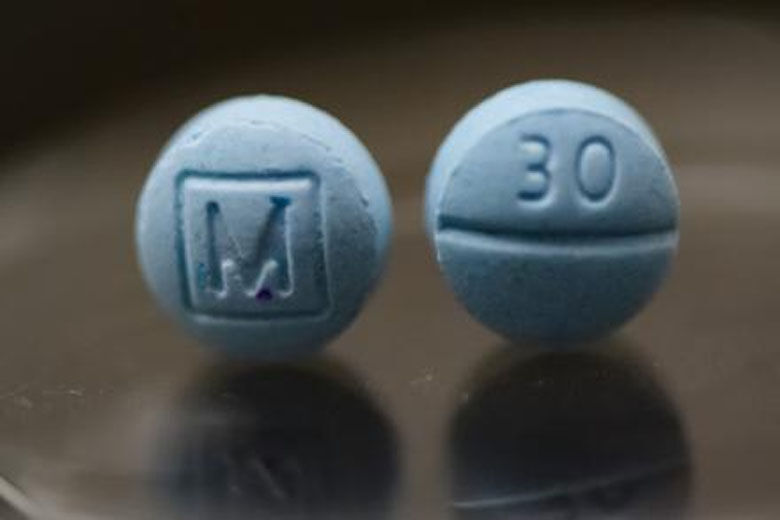This article is part of the WTOP series, “Facing Down Fentanyl: Teens Confront Drug Danger.”
This video is no longer available.
Doctors at the D.C. area’s top children’s hospital say they’re seeing a dramatic rise in the number of children coming to hospitals to be treated for fentanyl overdoses or seeking help beating an opioid addiction.
Since about last October, doctors have noticed “a significant increase in the number of kids coming in,” said Dr. Sivabalaji Kaliamurthy, medical director of the addiction clinic at Children’s National Hospital in D.C.
Kaliamurthy said another troubling aspect is that unlike in the past when overdoses resulted from other drugs being laced with fentanyl, for many kids, their first introduction into using opioids is fentanyl.
“These pills are not laced with fentanyl — they are fentanyl,” Kaliamurthy said.
It’s coming in the form of blue pills known as “fake pills” or “M-30,” which are designed to look like oxycodone pills that are stamped with M-30. But Kaliamurthy said the pills do not contain oxycodone, instead they contain fentanyl and other substances.

“So, the first point of entry into actually using opioids is fentanyl, which is different from adults who were prescribed something in the past and then they transitioned to fentanyl, because that’s what was available for them in the streets,” Kaliamurthy said.
It doesn’t begin with the pills
Kaliamurthy said the spiral into addiction and overdose for teens doesn’t always begin with the pills.
Read more from the series “Facing Down Fentanyl: Teens Confront Drug Danger”
- Unseen and unheard: Unique Maryland high school aims to help students beat addiction
- ‘Not my child:’ What a mother says you need to know about teens and fentanyl
- Md. school system races to battle fentanyl epidemic facing teens
What he and other doctors are noticing is that many kids they see moved to pills after using other substances in their middle school years, around the ages of 12 and 13. By 15, he said they usually turn to the “fake pills.”
“They have access. They’re seeing other people use it; then they want to try it to see how it feels like,” Kaliamurthy said.
It is also the kids who have used drugs other than opioids first who are, in many cases, more likely to experience an overdose. Their bodies may not be able to tolerate opioids, Kaliamurthy said, and if they mix the pills with other drug use, it makes the situation even more dangerous.
Between all these factors, doctors have also seen another concerning trend: The time between kids trying the pills and having a “full-blown problem,” is happening more quickly, according to Kaliamurthy.
Watch for the signs
There are behavioral changes all parents should look out for.
“They’re not going to school; their grades have declined; they’re hanging out with people they haven’t hung out with before; they’re more isolated,” Kaliamurthy said.
He said some kids may lose their friends or lose a significant amount of weight — in some cases up to 30 to 40 pounds.
Those aren’t the only signs. Watchful parents may also be able to spot evidence of drug use from the drugs themselves. With the M-30 pills, he said kids often crush them and snort them, so parents may spot white lines or dust in bathrooms or bedrooms. The drug is also taken by burning the pills on foil and inhaling the fumes.
“What parents often notice is that they start smelling burnt plastic smell around the house. That’s the smell that the foil creates,” Kaliamurthy said, adding that parents may also find pieces of foil around the house.
Getting your child the help they need
If you suspect your child is using drugs, confronting them about it can be a difficult conversation to start.
“It’s a scary time and you find out that your child may be experimenting or using these drugs, which have a high mortality due to the overdose risk,” Kaliamurthy said.
He said first, parents shouldn’t begin the conversation if they are emotionally worked up because it is important to stay calm when having these conversations. Children can become defensive when parents try to broach uncomfortable conversations.
“The challenge is we cannot force these kids into treatment,” Kaliamurthy said.
For parents, Kaliamurthy recommends parents take an online course that can help not only spot substance use, but also start difficult conversation. It’s called the CRAFT method — for Community Reinforcement and Family Training — and the course is free for Maryland residents.
How is it treated?
A treatment plan is determined by how severe the substance-use disorder is, Kaliamurthy said. In addition to drug use, underlying mental or physical conditions will also be looked at and treated.
More severe patients can be treated in an inpatient setting, which can include being admitted to a hospital. For others, an outpatient program may suffice.
As for the addiction, there are also drugs available that can help those addicted to opioids recover.
“The challenge is, it’s a very potent substance, it’s not easy to stop, even if you’re motivated, you might have ups and downs,” he said.
Kaliamurthy said for some patients, treatment is hard to find because most facilities do not accept Medicaid insurance for kids seeking substance use help, meaning low-income families often struggle to access treatment
It takes a village
Kaliamurthy said there’s an important role for the community to play to help cut off access to drugs. Also, he said more infrastructure needs to be in place to help kids with substance use disorders.
“Residential programs don’t exist; we need to advocate for more residential programs because a lot of these kids want help,” he said.
Oftentimes, better training for teens could help save lives. In many cases where a person dies from an overdose, another person was present who didn’t call for help. There is also Narcan, a device that delivers naloxone, which is an opioid-overdose antidote. Kaliamurthy believes Narcan should be accessible to everyone who is high-risk.
The bottom line, he said, is overdose deaths are preventable








